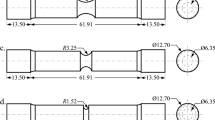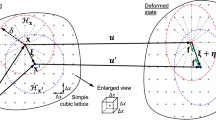Abstract
Our aim was to develop a method to construct a fracture locus for tensile loading with large positive values of stress triaxiality with only a round tensile specimen. Previously, at least three repetitions of tensile tests using a round tensile specimen, circumferentially notched tensile specimen and circumferentially cracked tensile specimen were required when we constructed the fracture locus. A fundamental idea considered in this study is to modify the Hancock and Mackenzie model by relating void nucleation strain to strain at necking and replacing the parameter in the model with a material constant depending on strain hardening coefficient. Validity of the proposed method was verified by comparing fracture loci constructed using the proposed method with data set measured by earlier researchers. Fracture loci constructed by the proposed method are in agreement with data set for ductile steels with yield stress in the range of 200-500 MPa and uniform strain of material is higher than 0.1.
Similar content being viewed by others
References
J. R. Rice and D. M. Tracey, On the ductile enlargement of voids in triaxial stress fields, J. Mech. Phys. Solids, 17 (3) (1969) 201–217.
J. W. Hancock and A. C. Mackenzie, On the mechanisms of ductile failure in high-strength steels subjected to multi-axial stress-states, J. Mech. Phys. Solids, 24 (2) (1976) 147–160.
Y. Bao and T. Wierzbicki, On fracture locus in the equivalent strain and stress triaxiality space, Int. J. Mech. Sci., 46 (1) (2004) 81–98.
Y. Bao, Dependence of ductile crack formation in tensile tests on stress triaxiality stress and strain ratios, Eng. Fract. Mech., 72 (4) (2005) 505–522.
G. Trattnig, T. Antretter and R. Pippan, Fracture of austenitic steel subject to a wide range of stress triaxiality ratios and crack deformation modes, Eng. Fract. Mech., 75 (2) (2008) 223–235.
G. R. Odette and G. E. Lucas, Irradiation embrittlement of reactor pressure vessel steels: Mechanisms, models and data correlations, Radiation Embrittlement of Reactor Pressure Vessel Steels—An International Review (Second Volume), ASTM International (1986) 206–241.
G. Qian and M. Niffenegger, Integrity analysis of a reactor pressure vessel subjected to pressurized thermal shocks by considering constraint effect, Eng. Fract. Mech., 112 (2013) 14–25
A. Ballesteros, E. Altstadt, F. Gillemot, H. Hein, J. Wagemans, J. Rouden, J. Barthelmesd, K. Wilfordg, M. Serranoh, M. Brumovskyi, R. Chaouadie and S. Ortner, Monitoring radiation embrittlement during life extension periods, Nucl. Eng. Des., 267 (2014) 197–206
W. H. Tai, Approximate calculation of fracture ductility and fracture toughness of ductile metals, Mater. Sci. Eng. A, 122 (2) (1989) 205–210.
M. Ohata, T. Fukahori and F. Minami, Damage model for predicting the effect of steel properties on ductile crack growth resistance, Int. J. Damage Mech., 19 (2010) 441–459
C. S. Oh, N. H. Kim, Y. J. Kim, J. H. Baek, Y. P. Kim and W. S. Kim, A finite element ductile failure simulation method using stress-modified fracture strain model, Eng. Fract. Mech., 78 (1) (2011) 124–137.
N. H. Kim, C. S. Oh, Y. J. Kim, K. B. Yoon and Y. H. Ma, Comparison of fracture strain based ductile failure simulation with experimental results, Int. J. Pres. Ves. Pip, 88 (10) (2011) 434–447.
F. M. Rashid and A. Banerjee, Implementation and validation of a triaxiality dependent cohesive model: experiments and simulations, Int. J. Fract., 181 (2) (2013) 227–239.
W. H. Tai, Plastic damage and ductile fracture in mild steels, Eng. Fract. Mech., 37 (4) (1990) 853–880.
W. H. Tai, Computer simulation of plastic damage evolution in cracked body of low-carbon steel, Eng. Fract. Mech., 54 (1) (1996) 141–146.
X. C. Yin and X. H. Liu, Investigations of fracture instability in crack growth for several metals-Part I: Experimental results, Int. J. Fract., 69 (2) (1994) 123–143.
L. Baotung, L. Xiaoyan and Z. Xiulin, Effects of microstructure on fatigue crack initiation and propagation of 16Mn steel, Metall. Trans. A, 20 (1989) 413–419
T. L. Panontin and S. D. Sheppard, The relationship between constraint and ductile fracture initiation as defined by micromechanical analyses, Fracture Mechanics: 26th Volume, ASTM STP 1256, W. G. Reuter et al. (Ed.), American Society for Testing and Materials, West Conshohocken (1995) 55–84.
J. Lemaitre, A continuous damage mechanics model for ductile fracture, Transactions of the ASME. J. Eng. Mater. Technol., 107 (1) (1985) 83–89.
M. Achouri, G. Germain, P. Dal Santo and D. Saidane, Experimental characterization and numerical modeling of micromechanical damage under different stress states, Mater. & Des., 50 (2013) 207–222
Author information
Authors and Affiliations
Corresponding author
Additional information
Recommended by Associate Editor Hak-Sung Kim
Yun-Chan Jang received the B.S., M.S. and Ph.D. in Mechanical Engineering from Chung-Ang University, Seoul, Korea, in 2007, 2009 and 2015, respectively. Until 2018, he worked as a researcher at Nuclear Analysis Team of Doosan Heavy Industries, Korea. He is currently working at KOGAS Research Institute, Korea. He is interested in damage model, fracture locus and numerical analysis of crack propagation.
Youngseog Lee received the B.S. in Mechanical Engineering from Pusan National University, Korea, in 1989. He then received the M.S. and Ph.D. from Case Western Reserve University, Cleveland, Ohio, USA, in 1992 and 1997, respectively. Until 2003, he worked as a researcher at POSCO Technical Research Laboratories, Pohang, Korea. He is currently a Professor in the Department of Mechanical Engineering, Chung-Ang University, Seoul, Korea. He is interested in the area of ductile fracture locus at high strain rate of steels and its applications to hypervelocity penetration.
Rights and permissions
About this article
Cite this article
Jang, YC., Lee, Y. A method to construct the fracture locus in the range of high stress triaxiality when only a round tensile specimen is available. J Mech Sci Technol 33, 1195–1201 (2019). https://doi.org/10.1007/s12206-019-0219-z
Received:
Revised:
Accepted:
Published:
Issue Date:
DOI: https://doi.org/10.1007/s12206-019-0219-z




